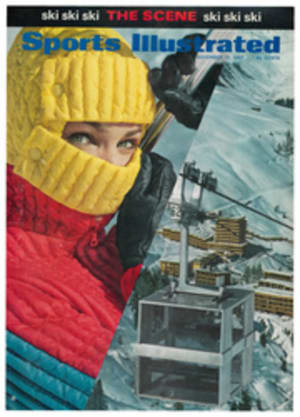
Numbers game for the tour
Golf has long been a game that refused to yield to the American passion for statistics, but rash is the man who thinks the computer won't catch up with him, and it has caught up with the pro golfer. Last April something known as the IBM Sports Information Service took to the road in a large trailer and followed the pro tour for 11 major tournaments, entertaining the galleries at the 18th green with vital, esoteric, surprising, mundane and arcane information that was being fed into a computer from all over the course.
Now IBM has taken the next logical step and asked the computer to sum up its observations. Admittedly, the sampling is small, but the results are still revealing. They show, for example, not only that Jack Nicklaus and Arnold Palmer are the best golf players around, which is hardly a surprise, but they also show why. And for the first time it can be seen that Palmer—once unsteady with his woods—has developed into a wonderfully consistent driver, while Nicklaus, who is driving not nearly so well, is overpowering golf courses with his recovery shots.
The chart at right tells the story. Palmer and Nicklaus drove the ball farther than four of the five other golfers whose overall performances were the best in the IBM tournaments (it should be noted that the length of the drives was measured on only two holes per tournament). They also got the ball on the green more often with fewer strokes. The only thing they did not appear to do best was putt.
Palmer's ability to hit 10% more fairways off the tee than Nicklaus and still drive within shouting range of Jack comes as something of a shock and raises the immediate question of why he does not beat Nicklaus easily, for Palmer has always been a good iron player. But it is seen that in the category of greens hit—which is what matters, since it is of no importance how far you hit a ball off the tee as long as you can hit the green in the same number of strokes as your opponents—Nicklaus immediately makes up the difference, and then some, for he is on the green in the proper number of strokes 76% of the time, compared to Palmer's 74%. There are some good reasons for this.
With his power and his ability to carry the ball in the air a long way, Nicklaus often drives over fairway bunkers that catch shorter off-line tee shots. This means he does not have to worry as much about the sand. Nor does being in the rough bother him as much as it does other golfers—even Palmer—for he is able to take advantage of his strength there, too, as he slams the club head through heavy grass and makes sharp contact with the ball in lies that would defeat anyone else. In short, in the IBM events, which included most of the big tournaments of the year, Nicklaus did not drive well, but paid a limited penalty for his tee-shot errors.
Bill Casper, who is widely acclaimed as the most subtle "mover" of the ball, turned up way down the list in both driving accuracy and greens hit. He drove in the fairway only 61% of the time, and he was on the green in regulation strokes only 66% of the time, the worst percentage of any of the seven golfers. Yet Casper led them in putting, with only 119.2 putts per tournament, which comes to 29.8 putts per round. And who was the worst putter in the group? None other than Nicklaus, the leading money winner in golf this year with five victories and $211,566 in purses. (Do you really drive for show and putt for dough?) Jack took 123.8 putts per tournament, or 30.95 putts a round. Presumably, that should give Casper a four-stroke advantage over Nicklaus in every tournament they play.
How Nicklaus partly overcomes Casper's apparent advantage is revealed in the very nature of the putting statistics. It seems, at first glance, strange that Nicklaus' putting should be so much less accurate than that of players whose records are far less impressive. Not only did he take more putts per event than Casper, but also 4.4 more than Dan Sikes, 3.8 more than Sanders and 1.6 more than Bobby Nichols.
But it is at points like this that statistics fail to reflect the vagaries of golf. The computer does not take into consideration the length of the putts. It is significant that Casper, Sikes and Sanders, who took the fewest number of putts among the golfers listed, also hit the least number of greens in regulation strokes. Obviously, their iron shots frequently were just off the green, and they were able to come out of bunkers or chip close enough to the hole to sink the subsequent putt. Nicklaus, Nichols and January took more putts, but they were hitting the greens in regulation figures from farther away and consequently were faced with more long putts.
The lone exception to the putting rule was Palmer, who was on the green almost as often as Nicklaus, yet took fewer putts than all but Casper, Sanders and Sikes. The conclusion is inescapable that despite Arnold's constant and much-published worries about his putting, he is a very good putter indeed.
The computer was also asked to compare the performances of the 10 top finishers in each of the 11 tournaments with the field as a whole in those events. It developed that the leaders averaged 69.85 strokes a round, while the average for the entire field was 73.1. Off the tee, the leaders averaged 270 yards a drive, six more than the field. They also kept their drives on the fairway 70% of the time, 10% more than the field. They reached the green in the regulation number of strokes 73.5% of the time, and while this is a figure that may give the duffer some solace—one missed green in every four holes—it is still 7.5% better than the field. And they took an average of 29.2 putts per round, which was a putt and a half less than the field. It is these slight variations in ability and performance that mean the difference between earning $100,000 a year on the tour and forever wondering whether to splurge on the chopped sirloin or stick to ham on rye.
The computer was also able to tell something about the courses that the tournaments were played on. As is only fitting, the U.S. Open at Baltusrol gave the golfers their toughest bout with par. The entire field averaged 4.3 strokes over par for every round, while Jack Nicklaus, the winner, was only 1.25 under par in setting an alltime Open scoring record. In terms of total strokes, the Columbine CC course at Denver, which was used for the PGA Championship, was half a stroke tougher per round, but Columbine played at par 72 as against 70 for Baltusrol. Firestone CC in Akron was third in difficulty behind Baltusrol and Columbine and second only to Baltusrol in relation to strokes over par. Behind Firestone came Colonial at Fort Worth.
The longest driving by the leaders was done at Baltusrol, a staggering average of 281 yards compared to 252 yards in the rain-deluged Westchester Classic. But Baltusrol got even on the greens where the 10 leaders averaged more than 31 putts a round. The greens were large, fast and hard to read. This figure can be compared with the 27.6 putts per round on the relatively small greens at the Cleveland Open, where the average score per round was 1½ strokes less than at Baltusrol. This says a lot about large greens; they can cost even the best putters four strokes a day.
Golf may never become a game for statisticians; there are too many intangibles connected with it. But it is interesting to think that IBM will have extensive statistics on a total of 25 tournaments next year, and the computer is going to destroy a lot of myths about why some golfers win or lose. Meanwhile, it is pleasant to be able to reflect on such unimportant matters as the fact that after Nicklaus, Nichols and Palmer the longest driver in the IBM events was Rod Funseth, that Al Geiberger has won $68,236 this year, but in the IBM tournaments he putted like a man with his arm in a sling (126 putts per event) and that George Archer has won $91,502 but in his six IBM events he was almost an even-money bet to hit the ball in the rough off the tee. Golf may be a game for CPAs after all.
[originallink:10540436:42994]

